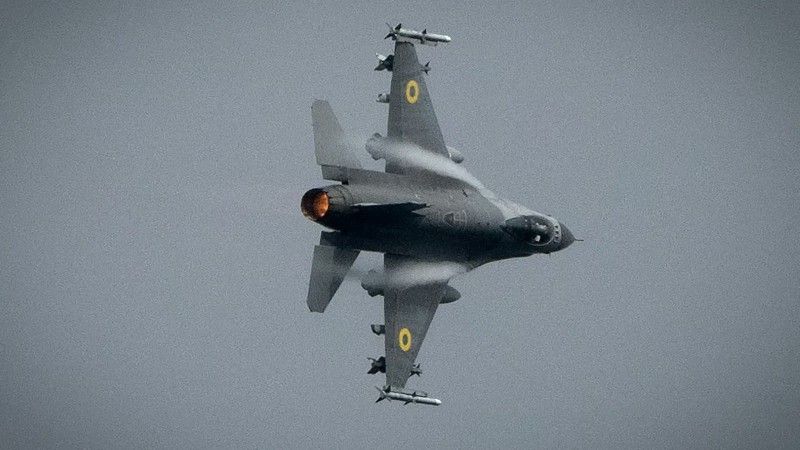Armed Forces
Why Did Ukraine Lose an F-16? A New Hypothesis [COMMENTARY]

Photo. Ukrainian Air Force
The initial information regarding the loss of the F-16 by Kyiv suggests either a friendly fire incident involving a Patriot missile or an accident. However, the cause of the incident may be related to both the training methodology adopted for the Ukrainian pilots, and deficiencies in weapons and support, including some negligence on the USAF part.
The crash of the F-16 resulted in the death of a Ukrainian pilot who was previously highly experienced with MiG-29 fighters. It is most likely that the aircraft was destroyed due to a cause other than direct enemy action, such as air-to-air or surface-to-air missiles. One hypothesis suggests that the plane might have been hit by a friendly Patriot missile, though this is considered unlikely.
A more straightforward explanation could be offered here. It is known that the Ukrainian pilot might have shot down four targets, three cruise missiles and a drone, before the incident. Engaging such targets is risky in the interception process, as these threats are small and (especially drones) fly at low speeds and low altitudes, forcing the fighter to operate under similar conditions, which increases the risk of a crash (to what extent this des happen depends on the specific nature of situation and the employed weapons).
In Ukraine’s case, there is an additional threat from long-range enemy air-to-air and surface-to-air systems, against which Kyiv has no countermeasures. One method of protection against these threats is to fly at lower altitudes, but this approach, particularly when chasing drones and missiles, instead of attacking safely from above with radar or targeting pods from a distance, increases the risk of a crash (impacting the ground).
Moreover, some Ukrainian aircraft seen in published images feature a distinctive configuration. They were armed with two Sidewinder missiles, two AMRAAM missiles, and two electronic warfare pods along with additional fuel tanks. It is possible that the Ukrainian pilot exhausted all of their air-to-air guided weapons and decided to engage the slow and low-flying targets with the aircraft’s gun, to protect civilians or infrastructure. This could have resulted in the jet impacting the ground, or being hit by fragmentation or rounds from own gun. Of course, this is just one hypothesis, and the circumstances of the incident need to be thoroughly investigated.
It’s important to note that F-16 fighters can carry a maximum of six air-to-air missiles. The Americans had already tested the use of APKWS laser-guided rockets as air-to-air missiles to combat cruise missiles and drones as early as in 2019, but it’s unclear if they have been implemented as such or are still used only in air-to-ground roles. The APKWS is cheap, it costs less than 50 thousand dollars a piece. The fact that U.S. fighters in the Middle East typically use Sidewinders rather than APKWS against drones suggests the latter, despite the fact that APKWS is more than 10-fold cheaper.
This might indicate that the USAF decided to wait for a better version of the APKWS missile, fully adapted for aerial targets, and that Ukrainian pilots were not trained to use these rockets for air-to-air combat (which also requires a targeting pod). For now, following the launch of 4 (up to 6) air-to-air missiles, the F-16 pilot can either return to base or risk using the Vulcan cannon.
We must remember that Ukraine operates F-16s under very specific conditions, in very limited numbers, without support from early warning and control aircraft, not to mention aerial refueling tankers. This means that NATO tactics for using these aircraft may not be fully applicable to Ukrainian conditions. However, attempting to apply tactics developed for the MiG-29 or Su-27, due to the significant differences in these aircraft, may prove impossible or carry excessive risk.
Unofficial information obtained by Defence24.pl indicates that there were frequent disagreements between Ukrainian pilots in training and their Western instructors regarding the use of F-16s, which could be attributed to the factors described above. Even Polish pilots, who trained for much longer and in peacetime, had significant difficulties transitioning to the F-16 system, especially considering the habits developed on MiG-29s, particularly in the period immediately after joining NATO, when allied procedures were not yet widely understood. The incident in Ukraine may have been influenced by some or all of the factors described above, as well as others, such as unofficially reported maintenance issues with these aircraft.
As for Ukraine, there is no simple solution here, though sending more F-16s and Western pilots/technicians as part of the International Legion could be helpful. Then, even at the risk of losses, the principles of using F-16s in Ukrainian conditions could be more easily developed, and the aircraft would be much more effective.
One thing is certain—there is essentially no turning back from providing F-16s (and other Western aircraft) to Ukraine. The capabilities of the MiG-29 and Su-27 are limited, as is their number, while Russia is strengthening its air force. Therefore, work must continue to ensure Kyiv can effectively use Western aircraft and minimize bureaucratic delays related not only to the delivery decision but also to equipping, servicing, and broadly supporting these aircraft.
